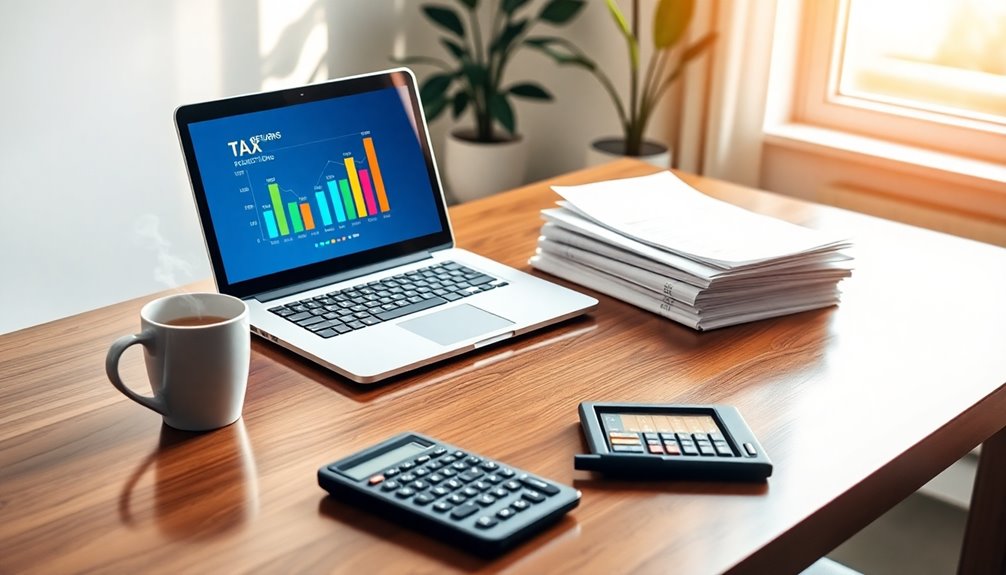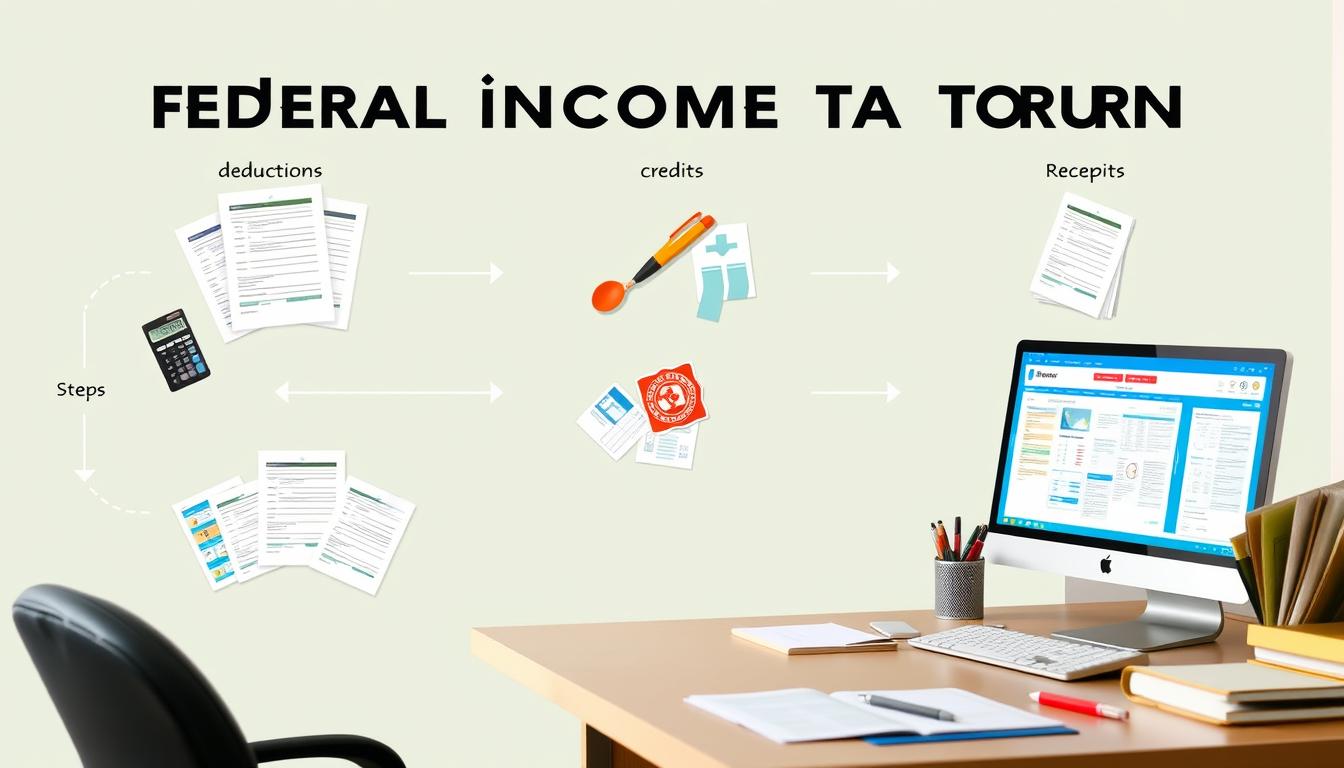You can pay your Indiana state taxes in several ways, making it easy to choose what works for you. To pay by mail, send a check or money order to the correct address based on your payment type. For convenience, use the Indiana Taxpayer Information Management Engine (INTIME) for online payments with your bank account or credit card. You can also pay in person at Indiana DOR District Offices or call 317-232-2240 for phone payments. If you owe more than $100, consider setting up a payment plan. There's plenty more to explore about these options.
Key Takeaways
- Pay Indiana state taxes online using the INTIME portal with a bank account or credit card (processing fees apply for credit card payments).
- Mail payments to specific addresses: PO Box 595 for separate payments, PO Box 7224 for payments with returns, or PO Box 40 for refunds.
- Visit Indiana DOR District Offices for in-person payments; options include checks, money orders, and credit/debit cards (processing fees apply).
- Set up a payment plan online or by phone if owing over $100 as an individual or over $500 as a business.
- Make phone payments by calling 317-232-2240, ensuring you have your last return or letter ID for verification.
Paying Taxes Through the Mail
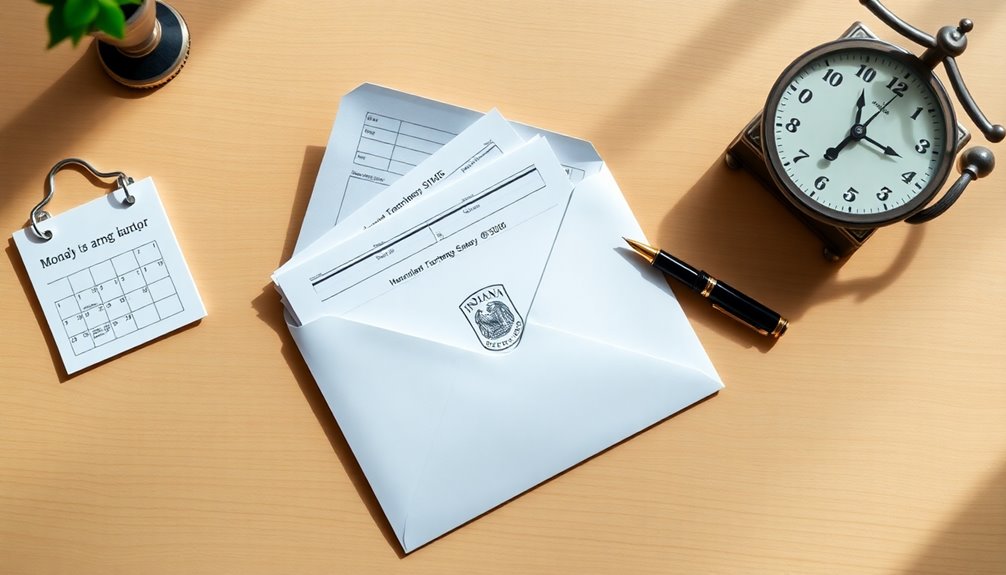
When it's time to pay your Indiana state taxes through the mail, make sure you have the right address handy. If you're sending your payment separately, use: Indiana Department of Revenue, PO Box 595, Indianapolis, IN 46206-0595.
However, if you're including payment with your return, send it to PO Box 7224, Indianapolis, IN 46207-7224. For refunds, remember to address it to PO Box 40, Indianapolis, IN 46206-0040.
You should pay by check or money order, making sure to write your account number or tax ID on the memo line. If you don't have a payment voucher, note your account number or tax ID directly on the check.
Include all necessary pages of your tax return, and don't forget to sign the second page of the IT-40 form if you're filing a full-year resident return. Additionally, ensure that your payment is sent in a timely manner to avoid late fees.
Make sure to include the complete filing instructions and any required income documents, but don't attach W-2s or 1099s unless necessary.
Lastly, check that the envelope is properly addressed, has enough postage, and keep a record of your mailing to track your payment.
Online Tax Payments
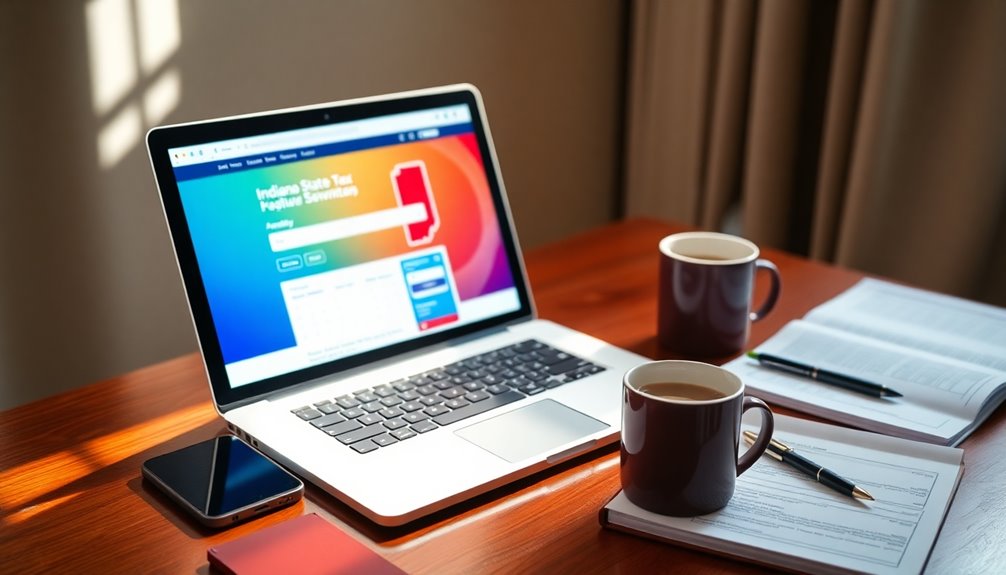
Online tax payments in Indiana offer a convenient and efficient way to fulfill your tax obligations. To get started, use the Indiana Taxpayer Information Management Engine (INTIME) for your online payments. You can pay using either a bank account or a credit card, but keep in mind that credit card payments come with a processing fee.
If you don't have an INTIME account, simply select "Make a Payment" and choose between "bank payment" or "credit card" under the Bill Payments tab. You'll need a letter ID from the Department of Revenue (DOR) to ensure your payment is credited correctly, and don't forget to provide an email address to receive your receipt.
Creating an INTIME account is easy; just go to the website and select "Sign Up." You'll need your Social Security Number and last name for verification. If you lack necessary details, you can request a welcome letter. Additionally, remember that quarterly payments are due on specific dates to avoid penalties, which can be managed easily through your INTIME account.
Once your account is set up, you can check your balance, make payments, and even set up payment plans as needed. Online payments streamline the process and help keep your tax obligations organized.
In-Person Payment Options
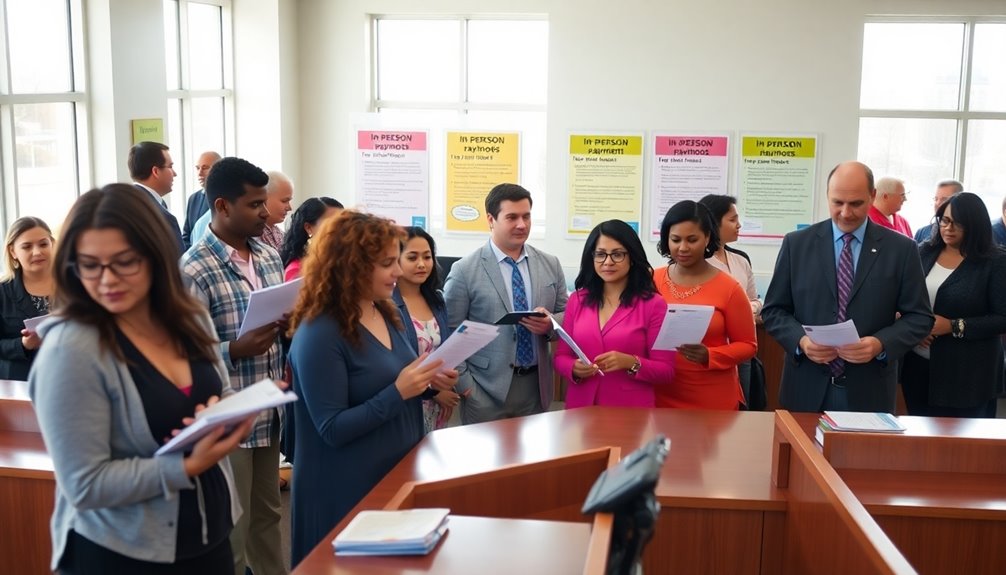
If you prefer to handle your Indiana state tax payments in person, there are several DOR District Offices available across the state, including locations in Bloomington, Clarksville, Columbus, Evansville, and Fort Wayne.
These offices are open from 8 am to 4:30 pm, Monday through Friday, so be sure to plan your visit accordingly.
When you arrive, you can pay using checks, money orders, cashier's checks, or credit and debit cards, though the latter two will incur a processing fee.
It's a good idea to bring exact change if you decide to pay with cash. To ensure your payment is credited correctly, include your account number or tax ID on the memo line of checks or money orders.
If you don't provide this information, a payment voucher may be required.
You'll receive a receipt for your payment, which is important for your records. Additionally, it's crucial to remember that sales tax collection can lead to penalties for late payments, so it's wise to make your payment on time.
To minimize wait times, consider making an appointment before your visit.
Phone Payment Process
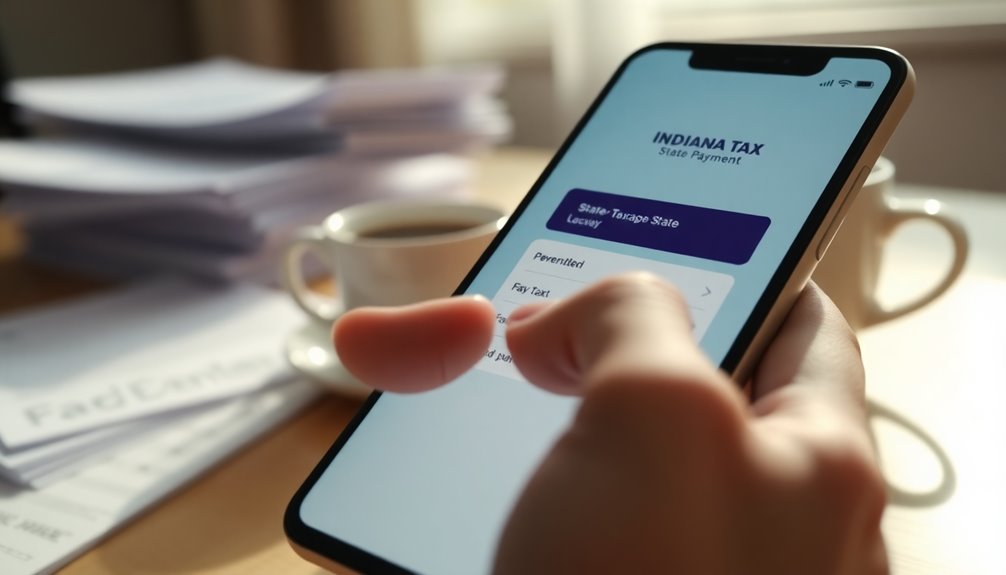
The phone payment process for Indiana state taxes offers a convenient way to settle your dues without needing to visit an office. To get started, call 317-232-2240.
Make sure you have a copy of your last return or a letter ID ready for identity verification. You'll need to provide personal and payment information, so ensure it's all at hand to avoid delays.
When making a payment, you can choose to use a bank account, credit card, or debit card. Remember, bank account payments are free, while credit and debit card payments come with a processing fee, which varies based on your payment method and amount. Electronic payments simplify the tax filing process for individuals and businesses, making it easier to manage your payment.
Once you dial the number, follow the automated prompts to select your payment option. Enter the required payment details, including the amount and method, and confirm everything to ensure accuracy.
After completing the payment, you'll receive a confirmation or receipt number as proof. You can make payments 24/7, so pick a time that works for you.
Keep that confirmation handy for future reference and be aware of any potential interest or penalties on your dues.
Setting Up Payment Plans
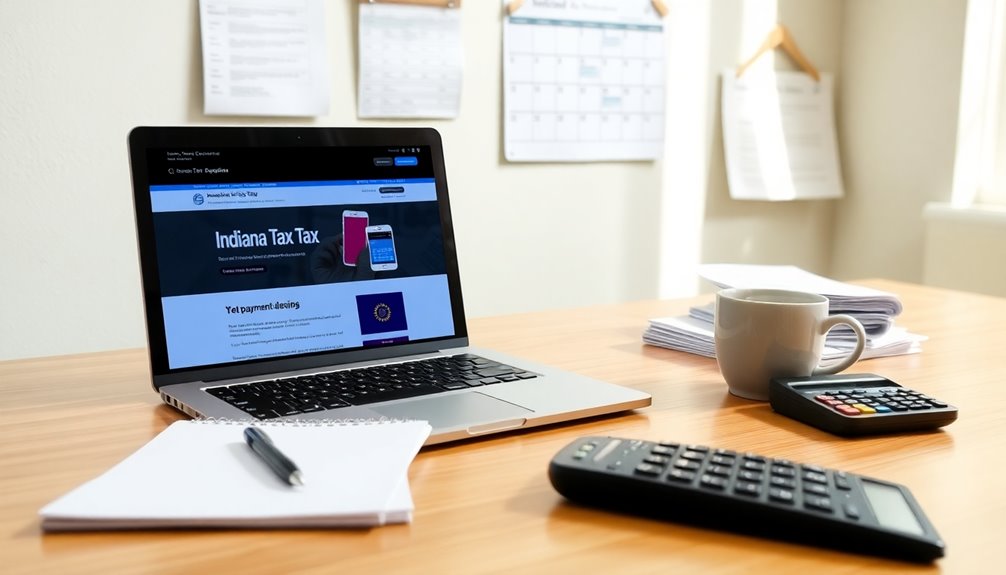
Setting up a payment plan for your Indiana state taxes can help ease the burden of outstanding balances. If you owe more than $100 as an individual or over $500 as a business, you're eligible to set up a plan. You can manage various tax balances, including income and business taxes.
For individuals, you can choose a plan lasting up to 36 months for balances between $101 and $1,000, and up to 60 months for amounts over $1,000. Businesses can have up to 24 months for balances between $1,001 and $5,000, and up to 36 months for amounts over $5,000. It's important to note that higher balances may qualify for extended durations.
To set up your plan, visit the Indiana DOR's website or call them directly. You can select your payment date each month, but remember, payments must be made manually; no automatic payments are available.
Keep in mind that additional fees and interest may apply, so staying compliant with tax laws and making timely payments is crucial. With no down payment required for many plans, you can work your payments into your monthly budget, making it easier to manage your tax debt.
Frequently Asked Questions
What Forms of Identification Are Needed for Tax Payments?
When you're preparing for tax payments, you'll need a few key forms of identification.
First, get your Federal Employer Identification Number (EIN), which the IRS issues.
You'll also need a Taxpayer Identification Number (TID) specific to Indiana.
Don't forget to have your business contact information and location details handy.
If applicable, ensure you have any additional state-specific identifiers, like sales tax or withholding tax certificates, ready for use.
Can I Pay My Taxes With Cryptocurrency?
No, you can't pay your taxes with cryptocurrency in Indiana.
The state requires tax payments to be made in fiat currency, like dollars. While some states allow crypto payments through third-party processors, Indiana doesn't have that option.
If you receive cryptocurrency, you'll need to convert it to USD for reporting purposes and pay your taxes accordingly.
Always check with a tax professional for the latest guidelines on your obligations.
Are There Penalties for Late Payments?
Yes, there are penalties for late payments.
If you miss the due date, you'll face a 10% penalty for not filing or paying your tax on time. Interest will also start accruing from the due date.
Additionally, if you don't file a return, you could incur a daily penalty of $10, up to $500.
It's crucial to pay on time to avoid these costly penalties and keep your tax situation manageable.
How Do I Check My Payment Status?
To check your payment status, visit the Indiana Department of Revenue's website and use the INTIME system.
Navigate to the payment status page, then enter your Social Security number, refund amount, and tax year. Your status will update in real-time.
Alternatively, you can call the automated line at 1-317-233-4018. Just have your Social Security number and refund amount handy to get the information you need quickly.
Can I Receive a Refund for Overpayment?
Yes, you can receive a refund for overpayment, but you need to file a claim with the Indiana Department of Revenue.
Make sure you include all necessary documentation and a complete explanation of the refund claim. Your submission must be made within three years of the tax due date.
If everything's in order, you could receive your refund within 90 days, but be prepared to address any issues if they arise.
Conclusion
Paying your Indiana state taxes doesn't have to be a hassle. Whether you choose to mail your payment, pay online, visit a local office, or call in, there are plenty of options to suit your needs. If you're struggling to pay in full, setting up a payment plan can ease the burden. Just remember to stay organized and keep track of deadlines to avoid any penalties. You've got this—make your tax payment process smooth and stress-free!




